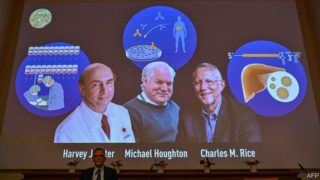This year’s winners identified the virus, and have thus saved many lives
THIS YEAR’S Nobel prize for physiology or medicine went to three of those involved in identifying the hepatitis C virus, which causes life-threatening infection of the liver and is passed on by exposure to contaminated blood. Though other widespread lethal infections such as malaria, HIV/AIDS and tuberculosis gain more attention, the World Health Organisation reckons that around 70m people are infected with hep C and that it kills 400,000 people a year. Hep C has also, in the past, turned the business of blood transfusion into a lottery, since there was no way to tell whether a particular batch of blood harboured it. That this is no longer the case is, in no small measure, thanks to the work of this year’s laureates—Harvey Alter, Michael Houghton and Charles Rice.
Dr Alter’s work came first. In the 1960s he was a colleague of Baruch Blumberg, who discovered the hepatitis B virus (for which he won a Nobel prize in 1976). Hepatitis viruses are labelled, in order of discovery, by letters of the alphabet. “A”, a water-borne pathogen, causes an acute infection that passes after a few weeks and induces subsequent immunity. The effects of “B” and “C”, though, are both chronic and may result eventually in cirrhosis and cancer. Blumberg’s discovery led him to a vaccine for hep B, and also meant that blood intended for transfusion could be screened. But it became apparent that such screened blood still sometimes caused hepatitis, albeit at lower rates. Since hep A was also being screened for by this time, that suggested a third virus awaited discovery.
In 1978 Dr Alter, then working at America’s National Institutes of Health, proved this was true by injecting into chimpanzees blood from recipients of transfusions screened for the known viruses who had nevertheless developed hepatitis. These animals sometimes then went on to develop the illness. It took, though, until 1989 to clone the new virus. That was done by Dr Houghton, who was then working at Chiron, a Californian biotechnology firm subsequently bought by Novartis.
Dr Houghton amplified viral genetic material drawn randomly from chimpanzees infected with the as-yet-unidentified virus and tested this against antibodies from infected humans. Antibodies are proteins crafted by the immune system to stick specifically to parts of particular pathogens. By looking at which chimpanzee-derived material the antibodies in question attached themselves to, Dr Houghton was able to isolate the virus and identify it as a type of flavivirus, a group that also includes yellow fever and dengue. He also thus provided a way of screening blood intended for transfusion.
Dr Rice, working at Washington University, in St Louis, Missouri, nailed down any lingering uncertainties about whether the flavivirus Dr Hughton had identified was the sole cause of hep C infections. Attempts to use cloned, purified versions of it to infect chimpanzees had not worked, leading to doubts about whether it was acting alone. Dr Rice identified part of the viral genome that looked crucial to the process of infection, but was highly mutable. He suspected this mutability was hindering successful infection in the laboratory, and was able to eliminate it by genetic engineering. The stabilised virus was, indeed, infectious to chimps.
The consequence of all this is that blood for transfusion can now be screened routinely for hep C, and drugs to treat it have now been developed. Unfortunately, this has not stopped the march of the illness. Those in rich countries have benefited. Deaths in Britain, for example, fell by 16% between 2015 and 2017. But the wider picture is grim. Some countries, such as Egypt, have done well recently. Others, less so.
One reason is that, besides transfusion, hep C is spread by injecting drug users sharing needles. It can also be spread sexually. This stigmatises it in the eyes of some. And unlike HIV/AIDS, which spreads in similar ways but quickly developed a political lobby to find a treatment once it was discovered, no one spoke up at the beginning for those suffering from the effects of hep C.
That is starting to change. In 2016 the WHO published a strategy for the elimination of all forms of hepatitis. The tools are there to do this. Whether the will to use them exists, remains to be seen.
By The Economist





